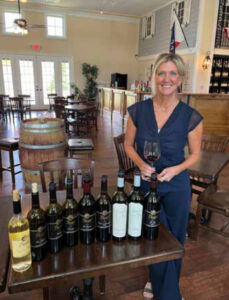ONE OF THE NEBBIOLO LEADERS IN VIRGINIA

Breaux Vineyards is a family owned and operated winery nestled in the Loudoun County, Virginia. It was in 1995 that the Breaux family launched into the wine business with the creation of this winery and only a few hectares of planted land. They grow quickly to become in 2024 one of the largest grape producers in the state. With a focus on quality and an investment in infrastructure, the estate stands out for its choice of unique grape varieties, such as Nebbiolo, which it planted after inspiration from Italy.
The emphasis is on the importance of terroir, the effect of vintage and the impact of climate, which vary from year to year. Finally, the estate looks to the future with innovative projects, seeking to strengthen its ties with the local community while preserving the identity of its wines.
Meeting with Jennifer M. Breaux, Président & General Manager.
VertdeVin: How did you get started with the vineyard ?
Jennifer M. Breaux: We started planting about 25 acres in 1995, and our first harvest was in 1997. The rest is history. We grew quickly – this area needed a place where people could taste great wines. We invested heavily in our infrastructure to create a beautiful place from the start.
This year, we produced around 8,000 cases; in the past, we’ve reached up to 14,000 or as few as 3,000. It depends on the vintage – we prefer to produce during better years and focus on growth in the best production sites. We initially bought some Chardonnay from a site to see if it met our quality standards to add to our portfolio, and it did. In 1998, we decided to plant our own Chardonnay, and today we are one of the largest grape growers in Virginia, with 95 acres. We select the best grapes for ourselves, and we sell the rest to colleagues to support the local industry and preserve its identity, which wouldn’t be the case if grapes were bought from California, Argentina, or other regions.
VertdeVin: Why did you plant Nebbiolo ?
Jennifer M. Breaux: Nebbiolo is an interesting grape. My father was traveling in Italy, in Alba and during a dinner, he had the chance to taste a Nebbiolo with a local producer. He fell immediately in love with this variety, and when he came back home, he decided to try planting it, even though his consultants told him it wouldn’t grow well here. But that’s not true – it grows very well. We have a small planting of Barbera that we bottle both as a varietal and in a blend with Nebbiolo that we call Six Degrees.
VertdeVin: What kind of terroir do you have ? What sets your wines apart ? How would you describe their signature ?
Jennifer M. Breaux: Our terroir is the fruit of the degradation of ancient mountains. We have alluvial soils with rich mineral deposits, granite particulate matter, silt, shale, clay and a high calcium content. The soils are well-dranined and retain warmth well. The vintage effect is strong here; Virginia is different from both France and California. I believe Loudoun County has its own distinct taste. We are focusing on Nebbiolo as it is a flagship wine for us. We have a very high demand for both Nebbiolo in the form of and what we produce in bottle. Our current vintage on the market is 2019; we first relase to our wine club members; we make 12 wines exclusively for our wine club each year, along with another 10 labels.
Simonit&Sirch pruning is practiced in many large properties around the world (Château d’Yquem, Château Latour, Domaine Leflaive, Louis Roederer, Marques de Riscal, Ramos Pinto, Biondi Santi, Feudi di San Gregorio, Quintessa, Corison, Shafer Vineyards…). It can be summarized by respecting four essential rules:
1) allow the plant to branch out with age (trunk and branches);
2) work on the continuity of the lymphatic flow;
3) make small cuts (minimally invasive) on young wood;
4) use the stump to prevent the main flow of sap from drying out.
VertdeVin: What can you tell us about the climate ?
Jennifer M. Breaux: The vineyard is exposed to high humidity, and the climate can be unpredictable. In some years, we may get a lot of rain, alternating with hot and sunny days, but one positive factor is the good diurnal temperature variation. Since I’ve been here, starting in 1997, we have always managed to bring in quality grapes during harvest. We have had a few drought years, but our climate is quite different than the climate on the west coast where drought is the rule not the exception.
Many thanks to Jennifer Breaux for her welcome !

